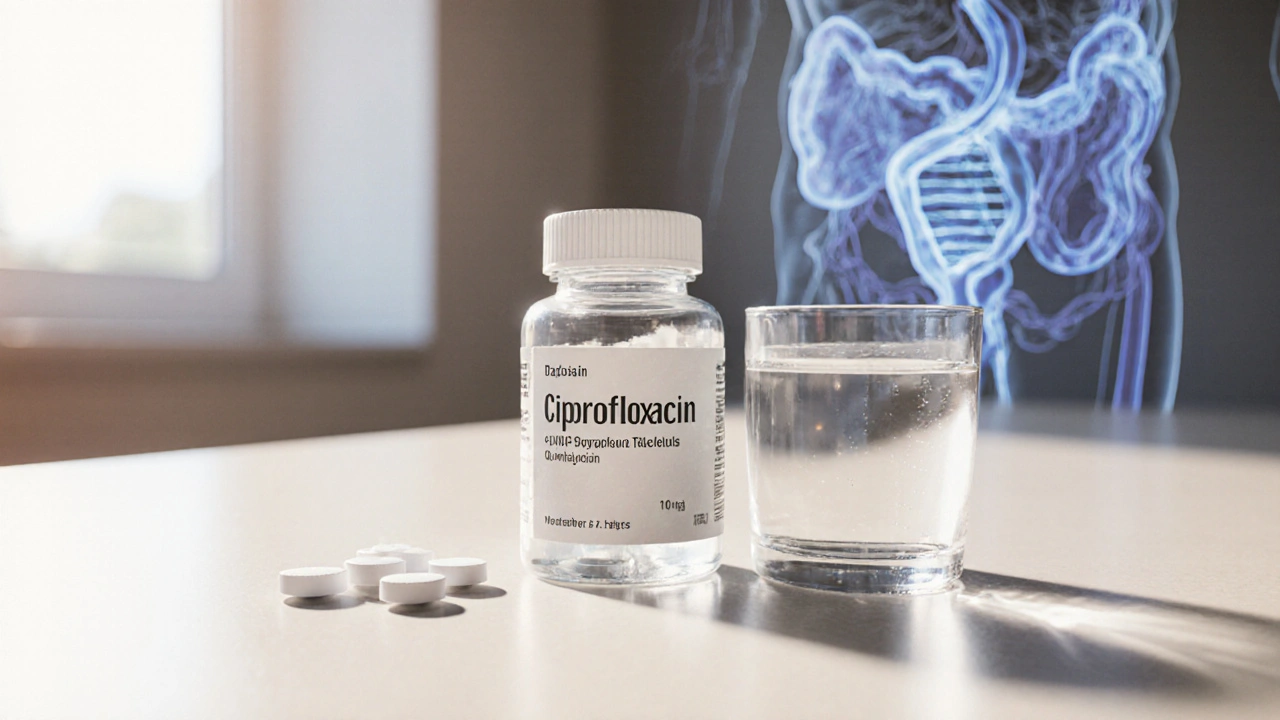Ciprofloxacin vs Alternatives Comparison Tool
Select an attribute to see detailed comparison.
Quick Reference Guide
- Ciprofloxacin - Best for UTIs, GI infections, and resistant gram-negative bacteria
- Levofloxacin - Similar to Cipro, with broader gram-positive coverage
- Azithromycin - Effective for respiratory infections, longer half-life
- Amoxicillin - First-line for many community-acquired infections
- Doxycycline - Good for atypical respiratory infections and tick-borne diseases
- Ciprofloxacin is a broad‑spectrum fluoroquinolone most often used for urinary‑tract and gastrointestinal infections.
- Levofloxacin, Azithromycin, Amoxicillin and Doxycycline are common oral alternatives with different bacterial coverage.
- Choosing the right drug depends on the infection type, local resistance patterns and patient‑specific factors such as allergies or pregnancy.
- Side‑effect profiles vary: Cipro can affect tendons and cartilage, while macrolides like Azithromycin are known for GI upset and cardiac QT‑prolongation.
- Consult a clinician before switching - self‑medicating can worsen resistance and safety risks.
When you’re prescribed an antibiotic, the name on the bottle often feels like a mystery. Ciprofloxacin alternatives pop up in pharmacy aisles and online forums, but how do you know which one truly fits your condition? This guide breaks down Ciprofloxacin (Cipro) side by side with the most frequently suggested substitutes, giving you the facts you need to discuss the best option with your doctor.
What Is Ciprofloxacin?
Ciprofloxacin is a synthetic fluoroquinolone antibiotic that interferes with bacterial DNA gyrase and topoisomerase IV, halting replication and leading to cell death. Marketed under the brand name Cipro, it was first approved in 1987 and quickly became a go‑to for gram‑negative infections.
How Ciprofloxacin Works
The drug binds to enzymes essential for unwinding bacterial DNA. By crippling these enzymes, ciprofloxacin stops bacteria from reproducing, making it bactericidal. This mechanism gives it strong activity against many gram‑negative rods, including Escherichia coli and Pseudomonas aeruginosa, while retaining moderate activity against some gram‑positive cocci.
Typical Uses for Ciprofloxacin
Physicians prescribe Cipro for:
- Uncomplicated urinary‑tract infections (UTIs)
- Acute bacterial prostatitis
- Traveler’s diarrhea caused by Campylobacter
- Intra‑abdominal infections following surgery
- Certain skin and soft‑tissue infections when resistant organisms are suspected
Major Oral Alternatives
When a clinician considers swapping Cipro, they often look at drugs that cover similar infections but belong to different antibiotic classes. Below are the four most common substitutes.
Levofloxacin is another fluoroquinolone, offering a slightly broader gram‑positive spectrum and a once‑daily dosing schedule.
Azithromycin belongs to the macrolide class, working by blocking bacterial protein synthesis. It’s prized for its long half‑life and convenient three‑day regimen.
Amoxicillin is a beta‑lactam penicillin that inhibits cell‑wall synthesis. It’s often the first‑line choice for otitis media, sinusitis, and many community‑acquired infections.
Doxycycline is a tetracycline antibiotic that also blocks protein synthesis, widely used for atypical respiratory bugs and tick‑borne diseases.

Side‑Effect Snapshot
Understanding safety is just as important as knowing efficacy. Here’s a quick look at the most reported adverse events for each drug:
- Ciprofloxacin: tendon rupture, peripheral neuropathy, QT prolongation, photosensitivity.
- Levofloxacin: similar tendon risks, higher incidence of CNS effects like dizziness.
- Azithromycin: GI upset, potential cardiac arrhythmias, rare liver injury.
- Amoxicillin: rash, occasional anaphylaxis, mild GI disturbance.
- Doxycycline: photosensitivity, esophageal irritation, tooth discoloration in children.
Comparison Table
| Attribute | Ciprofloxacin (Cipro) | Levofloxacin | Azithromycin | Amoxicillin | Doxycycline |
|---|---|---|---|---|---|
| Antibiotic Class | Fluoroquinolone | Fluoroquinolone | Macrolide | Penicillin (Beta‑lactam) | Tetracycline |
| Gram‑Negative Coverage | Excellent | Very Good | Fair | Moderate | Good |
| Gram‑Positive Coverage | Moderate | Good | Good | Excellent | Moderate |
| Typical Indications | UTI, prostatitis, GI infections | Community‑acquired pneumonia, sinusitis | Respiratory infections, chlamydia | Sinusitis, otitis media, skin infections | Rickettsial diseases, acne, atypical pneumonia |
| Standard Adult Dose | 500mg PO q12h | 750mg PO q24h | 500mg PO day1, then 250mg q24h ×4days | 500mg PO q8h | 100mg PO q12h |
| Common Side Effects | Tendon pain, nausea, photosensitivity | Dizziness, headache, tendon issues | Diarrhea, abdominal pain, QT prolongation | Rash, GI upset | Sunburn‑like reaction, esophageal irritation |
| Resistance Concerns | Escalating fluoroquinolone resistance worldwide | Similar to Cipro, especially in E.coli | Macrolide‑resistant Streptococcus pneumoniae rising | Beta‑lactamase producing organisms | Tet‑M mediated resistance in some gram‑negatives |
How to Choose the Right Antibiotic
Deciding between Cipro and its peers isn’t just a matter of “broad‑spectrum = better.” Consider these practical criteria:
- Infection Site: Urinary‑tract infections favor ciprofloxacin because it concentrates in urine. Respiratory infections often respond well to azithromycin or levofloxacin.
- Local Resistance Data: Check your region’s antibiogram. In many Australian cities, fluoroquinolone resistance in E.coli is above 30%, making amoxicillin‑clavulanate or nitrofurantoin better first‑line options for uncomplicated UTIs.
- Patient Factors: Pregnant or breastfeeding patients should avoid fluoroquinolones. Children under 18 are also contraindicated for ciprofloxacin unless no alternatives exist.
- Side‑Effect Tolerance: If a patient has a history of tendon injuries, macrolides or beta‑lactams are safer.
- Drug Interactions: Ciprofloxacin can increase levels of warfarin and certain anti‑diabetic drugs. Azithromycin has fewer CYP interactions but can affect statins.
Run through these checkpoints with your prescriber. The goal is a targeted, short‑course therapy that clears the infection while minimizing collateral damage to your microbiome.
Safety Tips When Using Ciprofloxacin or Alternatives
- Complete the full prescribed course, even if you feel better.
- Stay well hydrated; adequate fluids reduce the risk of crystal formation in the kidneys.
- Avoid high‑impact sports for at least a week after taking fluoroquinolones to protect tendons.
- Report any sudden joint pain, tingling, or visual changes to a healthcare professional immediately.
- If you’re on a medication that prolongs the QT interval, ask whether a macrolide like azithromycin or a fluoroquinolone is safer for you.
Frequently Asked Questions
Can I switch from Ciprofloxacin to another antibiotic if I experience side effects?
Yes, but only under medical supervision. Your doctor may choose a drug with a different side‑effect profile, such as amoxicillin for a simple UTI, provided the bacteria are susceptible.
Is Ciprofloxacin still recommended for uncomplicated urinary‑tract infections?
Guidelines now suggest nitrofurantoin or trimethoprim‑sulfamethoxazole as first‑line agents in many regions due to rising fluoroquinolone resistance.
What makes fluoroquinolones like Cipro and Levofloxacin distinct from macrolides?
Fluoroquinolones target bacterial DNA‑gyrase; macrolides inhibit protein synthesis by binding the 50S ribosomal subunit. This difference influences both the spectrum of activity and the types of adverse effects each class carries.
Are there any food or drink restrictions while taking Ciprofloxacin?
Avoid taking Cipro with dairy products or calcium‑fortified juices within two hours, as calcium can bind the drug and reduce absorption.
How long does it take for Ciprofloxacin to clear an infection?
Most uncomplicated infections improve within 48‑72hours, but the full course (usually 5‑7days) should be finished to prevent relapse and resistance.
Armed with this side‑by‑side view, you can have a knowledgeable conversation with your pharmacist or doctor. Remember, antibiotics are powerful tools-using the right one at the right dose is the best way to stay healthy while preserving their effectiveness for the future.

